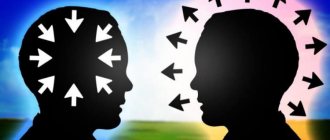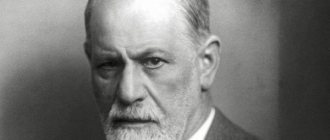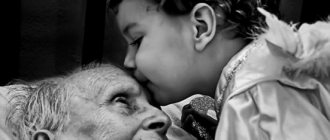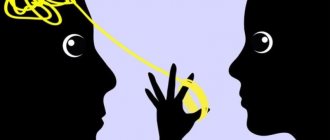What is this in psychology?
The unconscious is a set of various mental states and processes that are carried out under the influence of certain phenomena of the surrounding reality and the impact of which the individual is not aware of.
The reality reflected by a person is combined with his experiences.
An important feature of this mental process is that it is impossible to control it.
The human unconscious is the subject of study in such fields of knowledge as psychology and psychoanalysis.
Historical summary
The first mentions of the area of the unconscious, the processes that it contains, can be found in the works of Plato, namely in the doctrine of cognition-memory. This concept underwent fundamental changes after the publication of work on the study of consciousness by R. Descartes. He believed that beyond consciousness there could only be physiological, but not mental, activity of the brain.
The concept of the unconscious was first formulated by G. Leibniz in his work “Monadology”, published in 1720. He argued that it is precisely this that is the lowest manifestation of mental activity. In his opinion, this area is located on the border of conscious ideas.
An attempt to make an accurate materialistic description was made by D. Hartley. He combined the area of the unconscious with the work of the central nervous system.
The incentive for active study of the area of the unconscious, the mental processes that it contains, appeared after many successes in the study and development of psychopathology. To work with patients, specific techniques were used, with the help of which scientists influenced the area of the unconscious. A striking example is hypnosis.
Correlation with consciousness
In general, mental phenomena are divided into two groups:
- conscious , that is, those that a person is directly aware of,
- unconscious , which a person is not aware of.
It is the totality of these processes that constitute the psyche. Together they help a person adapt to the outside world.
At the same time, the area of influence of consciousness includes the management of complex forms of behavior that require the control and attention of the individual.
Despite this, it should be noted that most behavioral acts are committed precisely at the unconscious level.
Unconscious contents of the psyche
The category of the unconscious includes a variety of mental processes that have different names within the framework of different theoretical concepts. First of all, these are mental processes associated with automated behavior controlled under the cortical structures of the brain. This includes numerous signals coming from internal organs, joints, muscle spindles, skin surface, receptors throughout the body, the insignificant strength of irritation of which does not allow them to become a priority and be recognized. P.V. Simonov gives p uc . ll . l .
m. Frank.
Dwelling (Science. 1998. this group of mental phenomena May/June). the name is preconscious.
251
Patients who lose consciousness during surgery often report later that at that moment they heard doctors talking about their condition, felt the pressure of the needle with which drugs were injected, but could not move or communicate with others. Their memory was capable of retaining information about these events.
The unconscious also includes those phenomena that were once conscious and can be conscious again under certain conditions, but are currently not included in the sphere of consciousness. Indeed, every person at different moments in life is aware of a wide variety of information. Having ceased to be a priority, it does not disappear forever, but persists and waits in the wings. Moreover, it can participate in regulating human behavior without entering the realm of awareness. These unconscious contents are called preconscious
within the framework of the psychoanalytic concept and
the subconscious
according to the classification of P.V. Simonova.
And finally, the unconscious refers to the unconscious -
central concept of psychoanalytic theory. By definition, the unconscious is that part of the psyche whose contents cannot become conscious without the use of special (psychoanalytic) techniques. It includes instinctual desires, emotions and repressed thoughts (Figure 11.2).
The structure of the unconscious is absent in the concept of P.V. Simonov, but there is another structure in it - superconsciousness, or intuition. It, unlike the subconscious, devoid of creativity, is a source of new hypotheses and discoveries.
The division of the psyche into consciousness and unconscious processes raises the question of how information is translated into the category of conscious or unconscious. If for automated behavior and preconsciousness the reason for being outside consciousness may be the lack of priority or weakness of impulses (Libet, 1991) (this mechanism will be discussed in Chapter 12), then in the case of the unconscious, from the point of view of psychoanalysis, consciousness has special reasons not to allow its contents to become conscious.
Structure
The structure of this mental phenomenon includes:
- Unconscious actions. This includes gestures, facial expressions, vegetative reactions (trembling hands, redness or paleness of the face, etc.)
- Unconscious attitudes . They represent readiness for certain reactions or actions.
- Unconscious automatisms .
They are understood as actions that are performed without direct participation. This includes breathing, walking, swimming, etc. - Supraconscious processes . These are some sudden insights, which include inspiration, intuition, wisdom, etc.
Unconscious automatisms
The processes included in the subclass of unconscious automatisms are of a dual nature:
- never realized before (fundamentally not realized),
- once conscious, but at the moment occurring automatically (skills).
Examples of fundamentally unconscious ones: a child’s sucking movements, blinking, eye convergence, grasping objects, walking and much more. Examples of skills: playing a musical instrument, writing, speaking a foreign language, and an endless number of other skills.
It is worth noting that psychologists distinguish in the structure of consciousness:
- focus of consciousness (the most important thing at the current moment in time),
- periphery of consciousness (weak control by consciousness is exercised),
— the boundary of consciousness (the processes located here can either leave the field of human consciousness or enter it),
- unconscious.
Developed skills usually “balance” on the border of consciousness. If a person begins to make a lot of mistakes (when tired, for example, or when the activity becomes more complicated), then the skill again falls into the field of consciousness, to its periphery or even into focus. The skill is controlled, improved, and then returns again to the border of consciousness. This is what distinguishes skills from fundamentally unconscious processes, in that they “wander.”
Various examples of automatisms:
- when reading any text fluently, we do not think about the outline and meaning of individual letters, but “immediately” perceive the meaning of what we read,
- a radio operator working with Morse code, perceiving the sound of short and long signals, completely freely translates them into a logical combination of letters and words,
— entering a dark room, the hand “itself” reaches for the switch.
Kinds
The classification is as follows:
- Congenital . As the name suggests, we have it initially, from birth. It is divided into individual (attraction, instincts) and collective. Below we will look at the archetypes of the collective unconscious, who discovered them and what their essence is.
- Social . This includes attitudes, values and beliefs that appear and are formed in us during our upbringing, under the influence of others, primarily family.
- Repressed . It is formed under the influence of our censorship, when feelings and desires unacceptable to a person are transferred from consciousness to this area.
- Preconscious . This includes feelings and thoughts that were previously conscious, but have now lost their relevance and have been transferred to this sphere.
How to independently develop emotional intelligence? Read about it here.
Mindfulness and Love
A person confuses love with a lot of other states. Sympathy, love, emotional dependence, habit, sense of ownership. All this in popular culture is called love.
But love does not exist in an unconscious state. Feelings pass quickly, as they are an element of the unconscious perception of another person.
Love is a conscious renunciation of selfishness in favor of another person.
And this is a completely different level of feeling.
The less aware a person is of himself, the less true love he has.
Therefore, if you strive to find love, first try to gain awareness.
Unconscious human actions: examples
Such unconscious actions, as we have already said, include processes that occur unconsciously .
For example, in order to breathe, you do not need to control this process or say to yourself “inhale-exhale.” The person just does it and doesn’t even notice. The same thing, for example, with walking.
As an example, we can also cite some of the skills that we acquire. For example, driving a car or swimming . First, a person learns and understands these processes.
Then, as a result of many hours of practice, he no longer thinks about what movements he needs to make to swim or park.
Me and my desires
Unawareness is slavery to your momentary desires.
Leading an unconscious life always leads to associating oneself with one's lower needs.
Awareness is the setting of one’s “I” over desires, which, most often, do not reflect our true essence.
This is an opportunity to put yourself above the system that is your body.
In a state of unconsciousness there is no “I”. What a person associates with his own personality is constantly changing.
A conscious person leads the body towards the realization of aspirations determined by the mind. Unconscious - driven by orders from different senses.
The true “I want” is determined only in consciousness!
But not in the unconscious.
The popular call “Do what you want” is perceived differently by the mind and the unconscious.
For example, a conscious person puts his “I” above immediate feelings. He understands that he wants to make his contribution to this world, develop, find love, create conditions for maintaining and improving his health, acquire a favorite activity, become a professional in it and earn a certain amount of money for a happy life. Needs may differ, but they are always global in the scale of human life.
The unconscious person comes to the conclusion that she needs to buy beer, eat ice cream, troll online, or get any other momentary thrill in accordance with the level of development of the unconscious.
Hedonism does not lead to happiness precisely because it is not conscious. It does not satisfy the true needs of the individual. In an unconscious state, you cannot even see them.
Research methods
Methods of analysis or research were developed by S. Freud and his supporters, these are:
- free association method,
- dream analysis method.
The first method is based on the psychoanalyst deciphering a continuous stream of words reproduced by the patient . He looks for a pattern in them and, on its basis, makes a conclusion about the possible causes of a person’s mental state.
An example of this method is an associative experiment. The psychoanalyst names the word, and the patient must respond with the first thing that comes to his mind.
Sooner or later, the patient will begin to manifest words that are precisely connected with his hidden experiences.
Dream analysis is also carried out by identifying a person’s experiences. It is based on the theory that in dreams the control of consciousness is much weaker, and therefore the individual’s real anxieties and desires can emerge in dreams.
Lack of awareness is fixable
For everyone who recognizes themselves in the description of an unconscious person, there is good news: it can be fixed!
We all go through a phase of unawareness during childhood. The child does not think in terms of long-term goals; he is not able to understand the true reasons and meanings of his actions.
While consciousness has not yet developed in the little man, his survival is ensured by his parents.
An adult cannot afford to remain unconscious. However, each of us is, to one degree or another, susceptible to unconscious states. You just need to work through them without reproaching yourself for wrong actions or thoughts.
Developing mindfulness is hard work. But it always pays off by achieving higher tastes in life.
Job: technicians
There are various techniques for working with the unconscious that will help you understand your hidden feelings and desires .
Let's look at some of them.
- Dream Catcher . This technique is based on the dream analysis method. Its difference is that you need to write down your dream immediately after waking up, and try to do it in as much detail as possible. To do this, you can use a notepad, voice recorder or phone. Even if you wake up in the middle of the night, you need to record what you dreamed. The next day you should read/listen to what was recorded and try to understand what it might mean. As a rule, the message of the subconscious is presented in a dream in a direct way, so there are no difficulties with decoding. Please note that the key moment of sleep can be both your feelings and desires, as well as anxieties, fears, and experiences.
- A letter to myself. A very easy technique to perform.
You need to sit down and write yourself a letter. It should ask questions that concern you, turning to yourself. Ask what you feel, what worries you. Then immediately start writing a response letter. And here it is very important not to control yourself, just write down all the thoughts that arise. It is the response letter that will become a manifestation of your unconscious. - Inducing a trance. Take a comfortable position and start scanning different parts of the body. What does the right hand, sacrum, neck, back of the head, left heel, etc. feel? Gradually you will be immersed in a trance state. You can also induce a trance by repeating the same phrase mentally over and over again, like a kind of mantra. You can turn on music with the same rhythm. Once you reach this state, the unconscious itself will begin to give you clues. You will hear his voice and reveal your hidden feelings.
Mindfulness and Long-Term Thinking
The main criterion for awareness is long-term thinking. The more awareness, the more clearly a person predicts the future.
In an unconscious state, a person does not see the consequences of his actions.
The most vile traitors always hide among unconscious people. Unawareness disables the manifestation of higher human feelings: empathy, love, altruism. The intellect suffers.
Instead, we get callousness, fear, self-centeredness and stupidity.
A person performs actions that he desires in the future. Their consequences are sometimes irreparable.
It always takes a long time for an unconscious person to “catch up.”
What is visible from the position of awareness, regardless of the health of the unconscious, becomes obvious in the unconscious itself only when its state changes.
Only consciousness can make a long-term forecast.
Dictionary of antonyms
CONSCIOUSNESS - UNCONSCIOUSNESS
Consciousness of actions - unconsciousness of actions.
CONSCIOUSNESS - UNCONSCIOUSNESS
Tatyana suddenly decides to write to Onegin: the act is naive and noble, but its source lies not in consciousness, but in unconsciousness: the poor girl did not know what she was doing.
Belinsky. Works of Alexander Pushkin. People always love through something: through a word or through silence, through explosive passion or through restrained and subtle lyrics, through subordination or subordination of oneself, through the flesh or through the spirit, through consciousness or through unconsciousness, through similarities or through differences, and so on. further, and so on. Zalygin. After the storm. CONSCIOUS - UNCONSCIOUS Conscious - unconscious consciousness - unconsciousness consciousness - unconsciousness conscious - unconscious consciously - unconsciously consciousness - unconsciousness conscious - unconscious consciously - unconsciously awareness - unconsciousness conscious - subconscious consciously - subconsciously
Conscious efforts - unconscious efforts.
Ο Observing any act of memory, we will certainly notice in it a conscious element: we are aware of what we remember, and an unconscious element: we are not aware of what is stored in our memory. Ushinsky. Educational anthropology. One such conscious fighter is worth more than a hundred, albeit daring, but unconscious brave men. Furmanov. Conscious heroes. ~ In meaning noun Wed R. We know very well to what extent mental mental life is variegatedly composed of the conscious and the unconscious. I. Pavlov. Pavlovsk environments. But we will simplify the situation if we do not notice that Suvorov’s conscious often changed places with the unconscious. Lotman. Conversations about Russian culture. CONSCIOUS - UNCONSCIOUS
Conscious actions - unconscious actions.
Ο Behind this kind of attitude towards his biography as a writer, Astafiev sees a conscious or unconscious desire of critics to ensure that “the reader is as lenient as possible towards me.” F. Kuznetsov. I am responsible for everything. CONSCIOUS - SPONTANEOUS Conscious - spontaneous consciousness - spontaneous
Conscious actions - spontaneous actions.
Ο A realist is always a dialecticist by nature, conscious or spontaneous. Pudovkin. Realism, naturalism and Stanislavsky’s “system”. After the war, a rise in spirit is very possible. But it is required that this rise be conscious, and not spontaneous. M. Gorky. Letter from S.V. Malyshev, May-June 1915. CONSCIOUS - MACHINAL Conscious - mechanical consciousness - mechanicalness
Out of mechanical habit, the dog tucked its tail between its legs when it ran away from you, but it ran out of a conscious thought. Chernyshevsky. Anthropological principle in philosophy.
Issues
Scientists know for sure that the unconscious exists and influences human life. Processes occurring in the unconscious part of the psyche make you experience tension. It will be possible to reduce its intensity only if you transfer information from the unconscious layer to the conscious one. This can be prevented by protective mechanisms - resistance, repression. Customer service specialists are not always able to quickly overcome them.
The problem can be resolved through the use of techniques that make it possible to minimize the control of consciousness - hypnosis, projective techniques.
Irina Sherbul
Levels
The unconscious in a person’s personality has several levels:
- higher;
- average;
- inferior;
- personal;
- collective.
Psychology still does not give a definitive answer as to what other components the structure of the unconscious may include. Its components may differ in different methodological approaches. In addition, there are no reliable, absolutely reliable methods for studying this part of the human psyche.
The differentiation of the levels of the unconscious sphere that modern psychologists use reflects qualitative characteristics.
First signs
The following are signs that precede syncope:
- causeless anxiety, weakness, incessant yawning, heavy breathing;
- pale skin, sweating;
- headaches that bring a pressing or squeezing sensation, noise in the ears (ringing in the ears may be present), dizziness, hearing problems, suffocation;
- adrenaline rush, accompanied by heat at the end of the fingers;
- darkening before the eyes;
- tonic convulsions;
- a sharp increase or decrease in pressure, heart rate increases;
- nausea, vomiting, sour taste in the mouth.
Fainting is characterized by the presence of the following manifestations:
- the muscles are relaxed and the body is motionless;
- breathing slows down;
- blood pressure decreases;
- in case of deep fainting, the occurrence of convulsions and incontinence cannot be excluded;
- Pupils dilate, in the presence of serious pathologies, there is no reaction to light.









